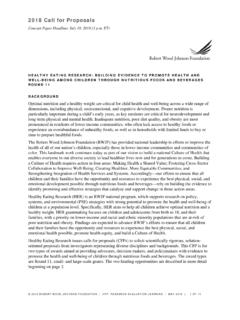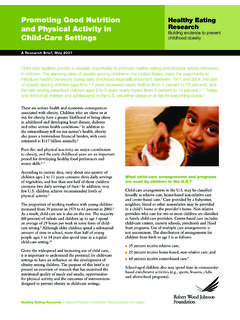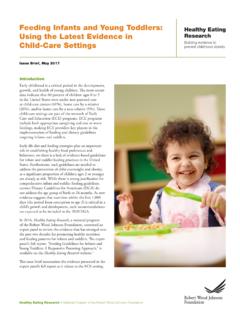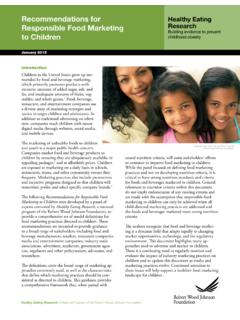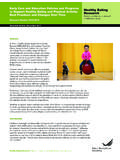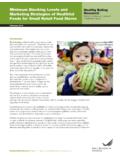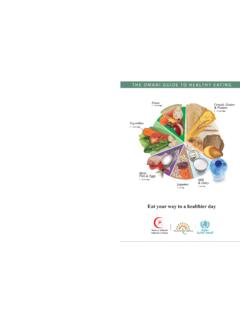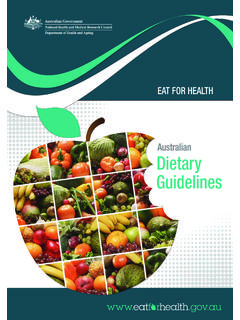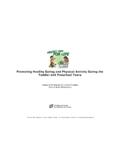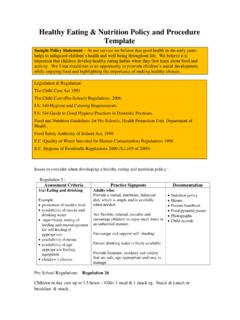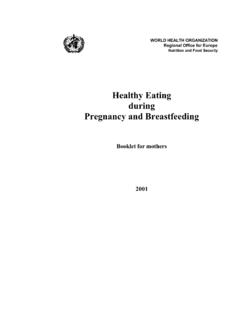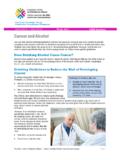Transcription of School Fundraisers: Healthy Eating Positive …
1 Healthy Eating Research and Bridging the Gap are programs of the Robert Wood Johnson of foods that are high in calories and low in nutrients has been clearly linked to adverse health outcomes in childhood, including an increased risk of childhood For nine months of each year, most children spend the majority of their waking hours at School . As a result, schools are a crucial setting for teaching kids the importance of Eating Healthy foods and beverages, and providing access to them too. Between one-third and one-half of children s and adolescents daily caloric intake occurs at School ,2,3 and a growing body of literature shows that School practices are associated with students dietary behaviors and weight School -wide nutrition practices such as engaging in food-related fundraising may also be associated with students Fundraisers on campus can be problematic nutritionally because, historically, foods such as baked goods, candies, and sugary drinks have often been sold as a part of these fundraising Consumption of empty calories from the solid fats and added sugars in such products are major contributors to childhood The top sources of calories for 2- to 18-year olds are sugar-sweetened beverages (SSBs)
2 Such as soda and fruit drinks, followed by grain-based desserts such as cakes, cookies, donuts, and variety of activities can be used to generate financial revenue for schools and associated clubs and student groups; furthermore, the uses of such revenues can vary widely across schools and districts. At the secondary level, many schools have dozens of clubs, student activity groups, and sports teams, most of which seek to raise funds for supplies, School Fundraisers: Positive Changes in Foods Sold, but Room for Improvement RemainsIssue Brief, March 2016 Healthy Eating Research Bridging the GapPrepared by Lindsey Turner, PhD, Boise State University; Jamie Chriqui, PhD, MHS, University of Illinois at Chicago; and Yvonne Terry-McElrath, MSA, University of Michigan. Peer review was provided by Lorrene Ritchie, PhD, RD, Nutrition Policy Institute, Division of Agriculture and Natural Resources, University of California, and Marlene Schwartz, PhD, Rudd Center for Food Policy and Obesity, University of Connecticut.
3 Travel, uniforms, and other expenses. Likewise, elementary schools often have parent-coordinated organizations that devote considerable effort to raising funds for similar purposes. Such fundraising activities can include appeals for direct (cash) donations, door-to-door sales in the community, and occasional activities such as bake sales and ice cream socials. They also include regular/frequent sales of beverages or food items such as pizza during lunchtime. In addition, revenue from vending machine sales, School stores, and la carte sales in the cafeteria have been a source of funds for many schools and/or student groups. Other School events, while not always considered fundraising, can also introduce unhealthy products into the diets of children and adolescents. Food and beverage marketing, exclusive contracts and sales incentives for beverages sold through vending machines and other venues, food coupons, and event sponsorships are 2 Issue Brief | School Fundraisers: Positive Changes in Foods Sold, but Room for Improvement Remains March 2016several ways in which advertisers gain access to schools, often providing financial incentives to schools for such ,14 Some schools participate in sponsored fundraisers at restaurants, whereby a portion of the profits on a particular night are provided to the School .
4 Repeated exposure to such marketing can impact children s subsequent food choices and brand preferences, even outside of the School In effect, schools are being used to market unhealthy foods to children and adolescents. The one-time revenue received by schools for such access is probably minimal, but the long-term consequences of children developing unhealthy dietary preferences are profound. The primary focus of this issue brief is on the types of in- School fundraising activities that include the sale of unhealthy foods and beverages on campus during the School day. This brief also describes potential strategies that may offer opportunities for schools to successfully raise funds without adversely impacting student EvidenceThis brief reviews previously reported research on this topic, and presents new data from the Bridging the Gap (BTG) research program. Information gathered during the 2013 14 School year from surveys of nationally representative samples of 640 public elementary schools18 as well as from 300 public middle schools and 312 public high schools19 are provided.
5 In addition, nationally representative data from a corresponding sample of 748 public School districts collected as part of BTG s National Wellness Policy Study20,21 during 2013 14 are provided. Food-related fundraising is common and has been in existence for many years. nIn 2006, the Centers for Disease Control and Prevention s nationally representative School Health Policies and Programs Study found that the sale of foods and beverages at School or in the community, for the purposes of raising money for a School -sponsored activity, occurred at 76 percent of elementary schools, 78 percent of middle schools, and 84 percent of high nFundraising strategies such as pizza dinners or ice cream social nights at School , and sponsored fundraiser nights at local restaurants, are not required to comply with Smart Snacks nutrition guidelines. However, they are still common ways in which children and families are exposed to unhealthy foods and beverages for the purpose of generating financial support for schools.
6 Nationwide survey data from the Centers for Disease Control and Prevention found that in 2006, such fundraisers were conducted by 25 percent of K-12 nBTG data from 2013 14 indicated that pizza dinners or ice cream socials were held at 62 percent of elementary schools. Sponsored fundraiser nights at local restaurants were held by 57 percent of elementary schools, and 23 percent of elementary schools held these events more than three times per year. The past decade (2005-2015) has brought a variety of changes to the School food environment, including food sold at School fundraisers. nFollowing the requirement22 that School districts develop wellness policies, which took effect as of the start of the 2006 07 School year, districts have increasingly addressed fundraising practices in their local wellness nSchool nutrition has also been an increasing focus of national policy efforts in the past five years, following passage of the Healthy , Hunger-Free Kids Act of 2010 and the ensuing Smart Snacks School nutrition standards that went into effect in July 2014.
7 The Smart Snacks standards define the portion sizes and types of beverages and foods that may be sold outside of School meals on School campuses during the School day, defined by the Department of Agriculture as 12:01 AM until 30 minutes after the final School These standards primarily impact three venues: vending machines, School stores or snack bars, and la carte lines in the cafeteria. nThe Smart Snacks standards allow for occasional special exemptions for fundraisers, whereby non-compliant items may be sold on campus during School The number of allowable fundraiser exemptions is left up to the agency in each state that oversees child nutrition 3 Issue Brief | School Fundraisers: Positive Changes in Foods Sold, but Room for Improvement Remains March 2016to be significantly associated with higher weight outcomes among teens in Minnesota middle nNational research using data from 2003-2007 showed that weight outcomes among middle School students were healthier in states where laws restrict foods sold in schools, compared to states without such This suggests that nutrition regulations may be a key strategy for improving student health.
8 Typically, these laws restrict the food sold in vending machines and in cafeteria la carte lines, as well as food given as rewards and made available at School fundraisers. nPrior to Smart Snacks, some schools were already subject to fundraising limits at the School site level, but these limits were fairly uneven. As shown in Figure 2, BTG data from 2013 14 indicate that across elementary, middle, and high School levels, about half of students attended schools that had nutrition-related limitations on foods and beverages sold at fundraisers. Fewer than 20 percent of all students attended schools where the School administrator indicated that the School either did not have fundraisers or only allowed Healthy foods to be sold at fundraisers. nOne possible explanation for the limited restrictions on fundraisers in schools is the fact that prior to Smart Snacks standards, state laws and district policies in this area were lacking (Figures 3 and 4).
9 Programs, and currently there is much variability in the number of exempted School fundraisers that states permit. nAlthough many states have a zero-exemption policy in other words, any products sold on campus as a fundraiser must comply with Smart Snacks standards others have allowed exemptions, in some cases for many days per School year. Figure 1 shows which states have a zero-exemption policy and which allow exemptions, as of December 1, However, these state policies may have changed since publication of this evidence indicating a need to serve only Healthy foods at fundraisers was available even before Smart Snacks, but School practices and state- and district-level policies did not reflect that evidence. nSchool-wide food practices such as fundraising in addition to other practices such as using food as a reward for good behavior or academic achievement, and allowing food in classroom parties were shown in a 2005 study Zero-exemption states Exemption statesFigure 1: State Fundraising Exemption PoliciesSource: Piekarz E, Chriqui JF, Lin W.
10 Smart Snacks fundraiser Exemptions. Chicago, IL: National Wellness Policy Study, Institute for Health Research and Policy, University of Illinois at Chicago; 2015 (forthcoming online).Figure 2. School Limits on Fundraising, 2013-14 School Year (Percent) Elementary Schools Middle Schools High SchoolsAny limits on fundraisers454050 Limits on soda211924 Only Healthy food allowed111012No fundraisers922 Percentage of students50254 Issue Brief | School Fundraisers: Positive Changes in Foods Sold, but Room for Improvement Remains March 20165025restrictions together are associated with healthier School As shown in Figure 5, schools are far more likely to report that they follow nutritional limits regarding fundraising practices when state- and district-level policies exist. However, additional information is needed about which schools comply with district- and state-level policies, and which do not.

